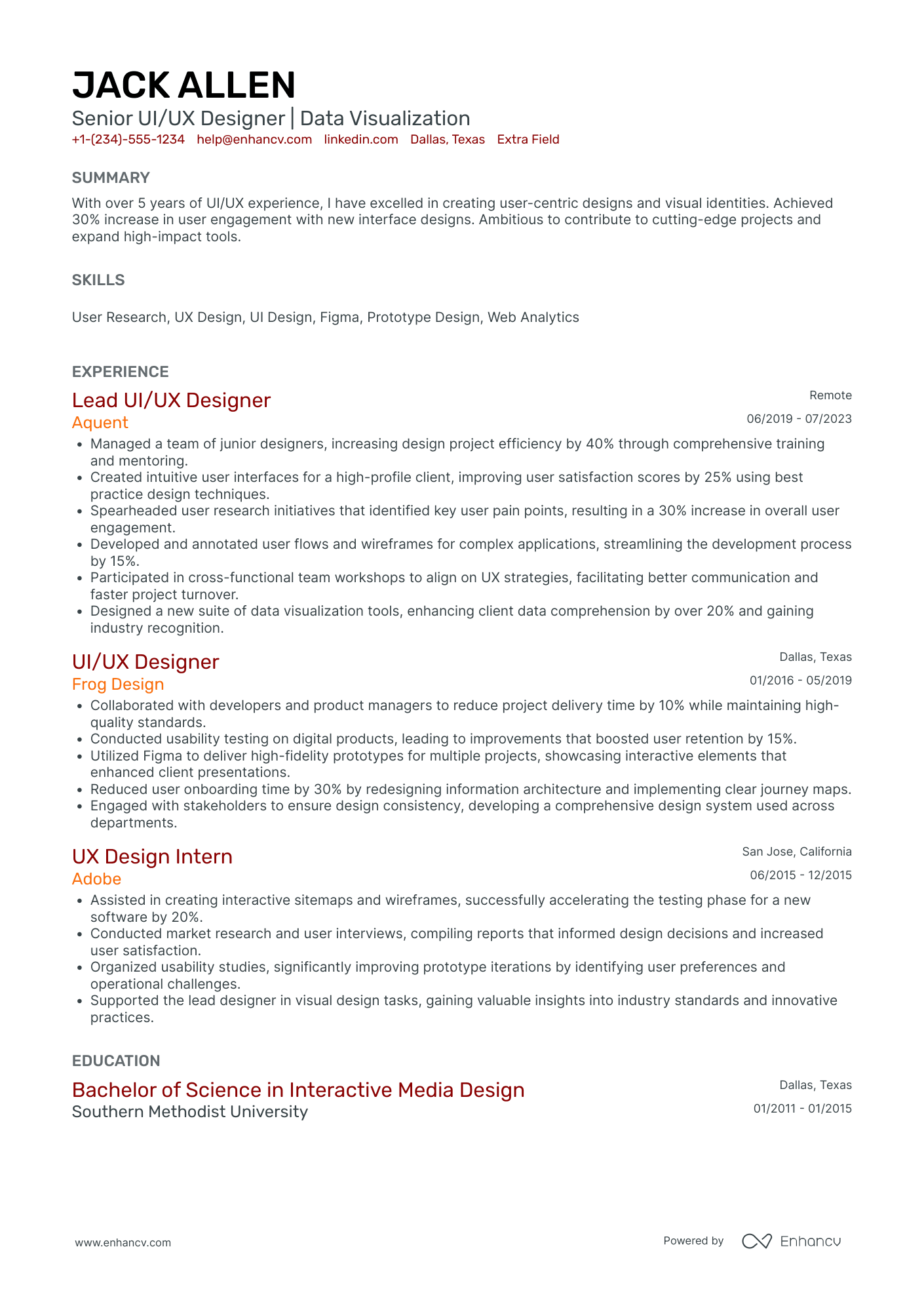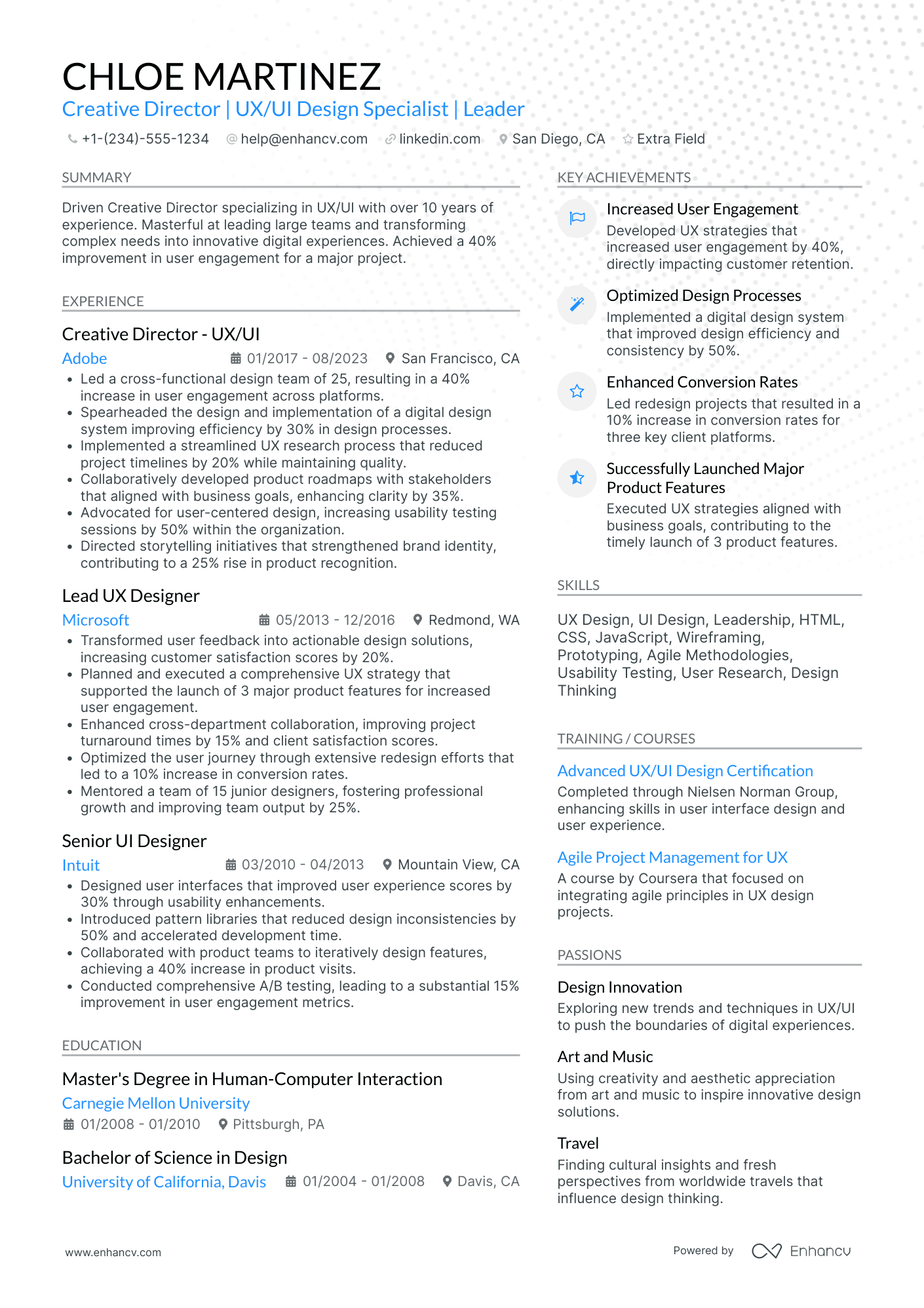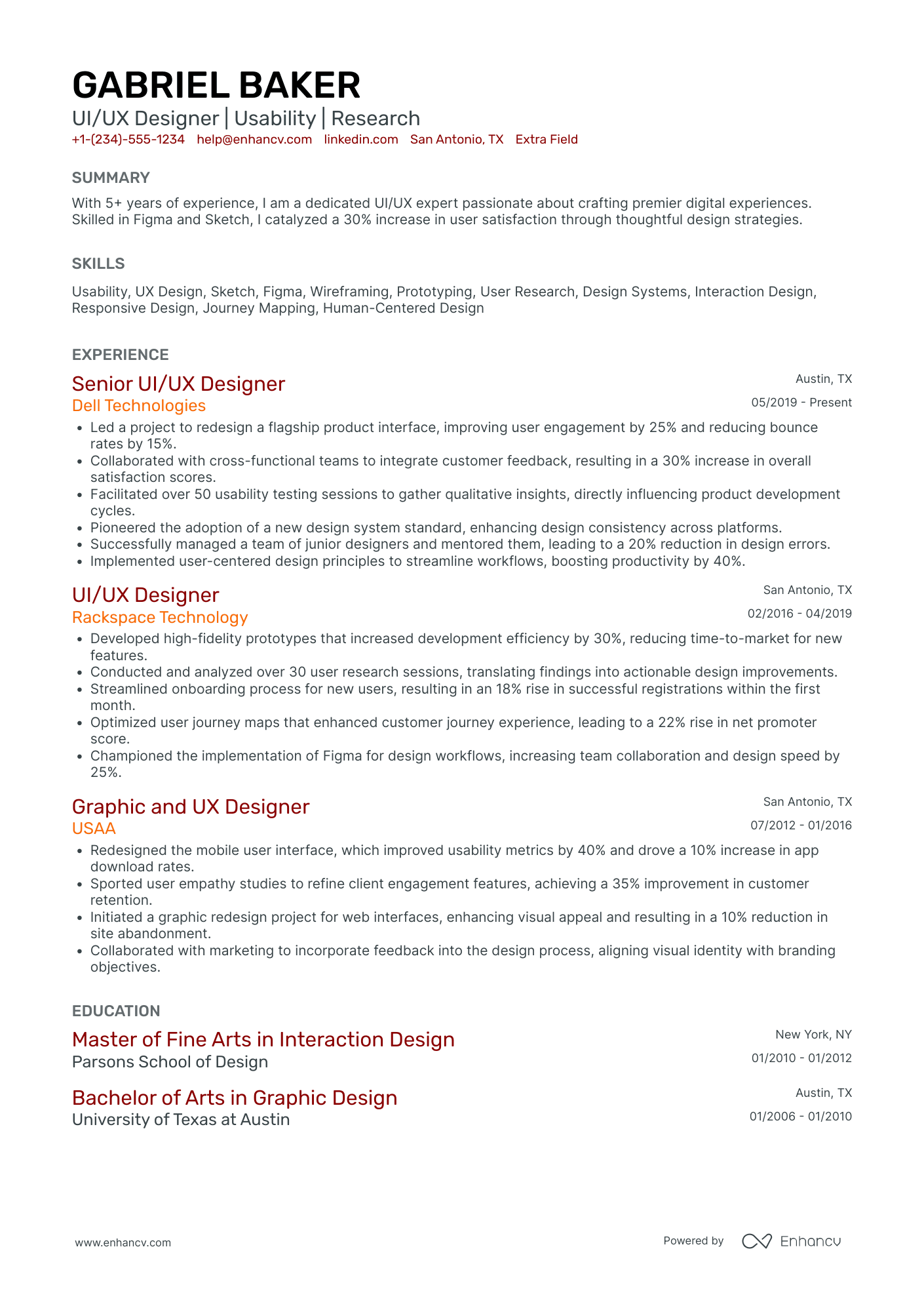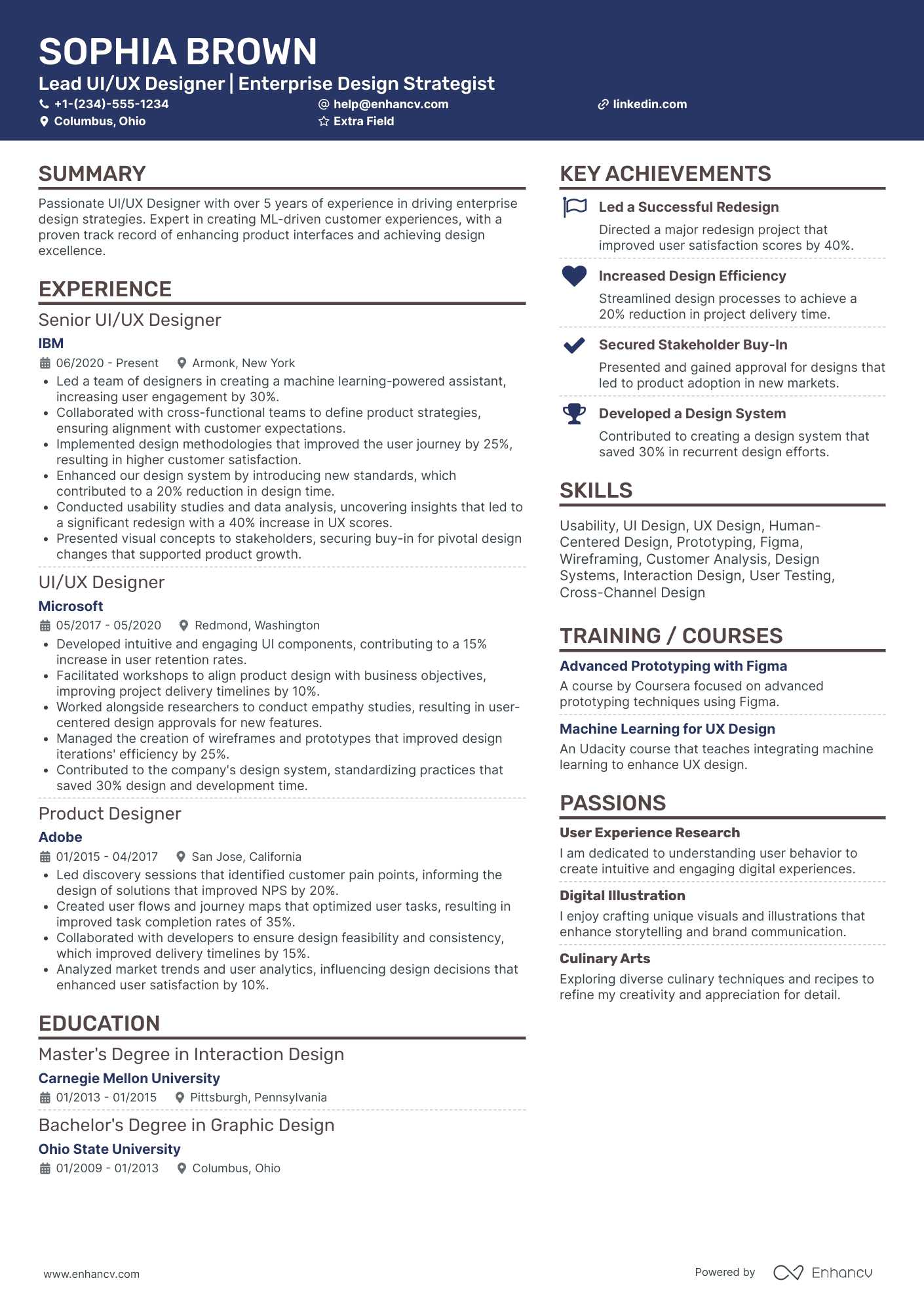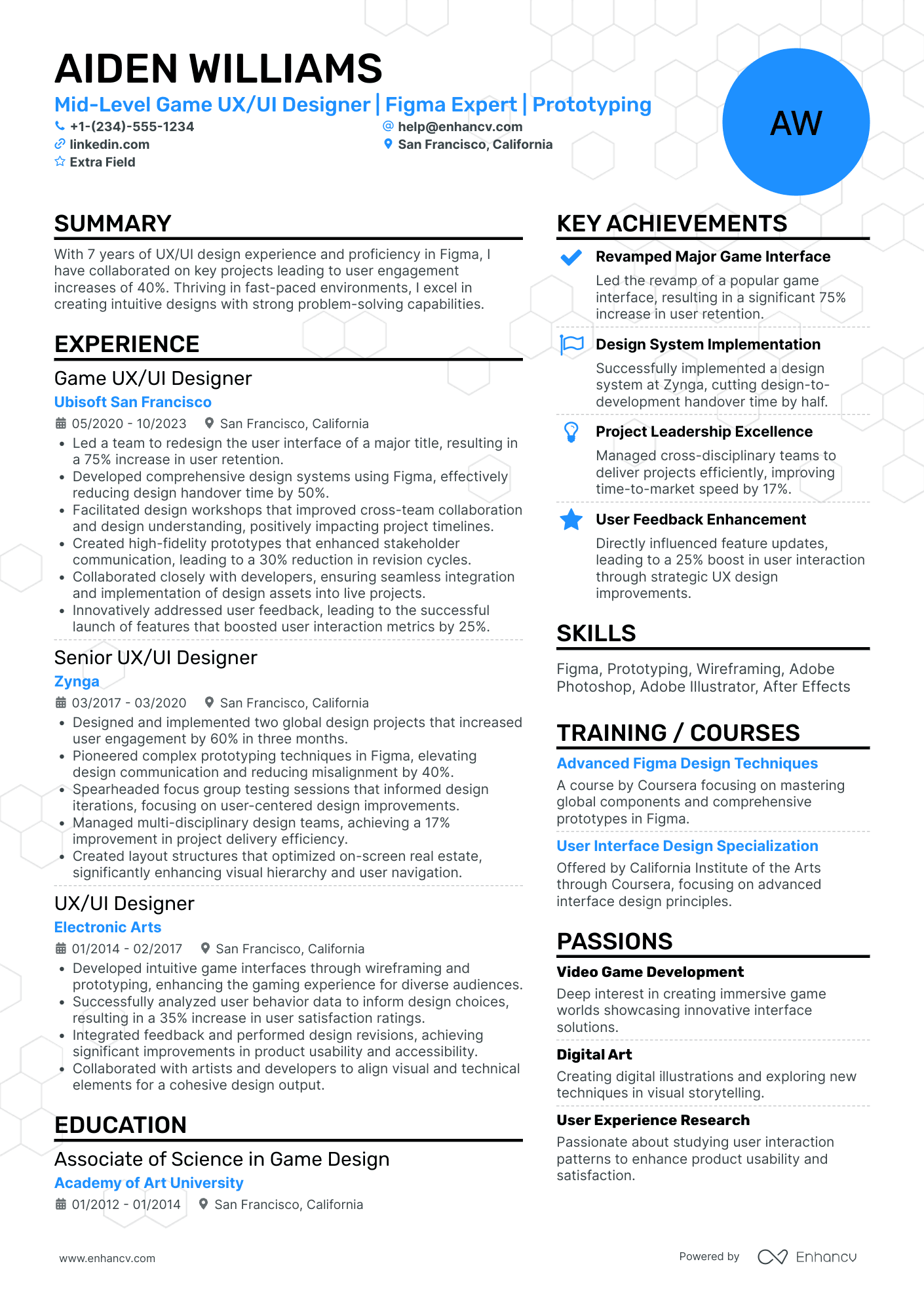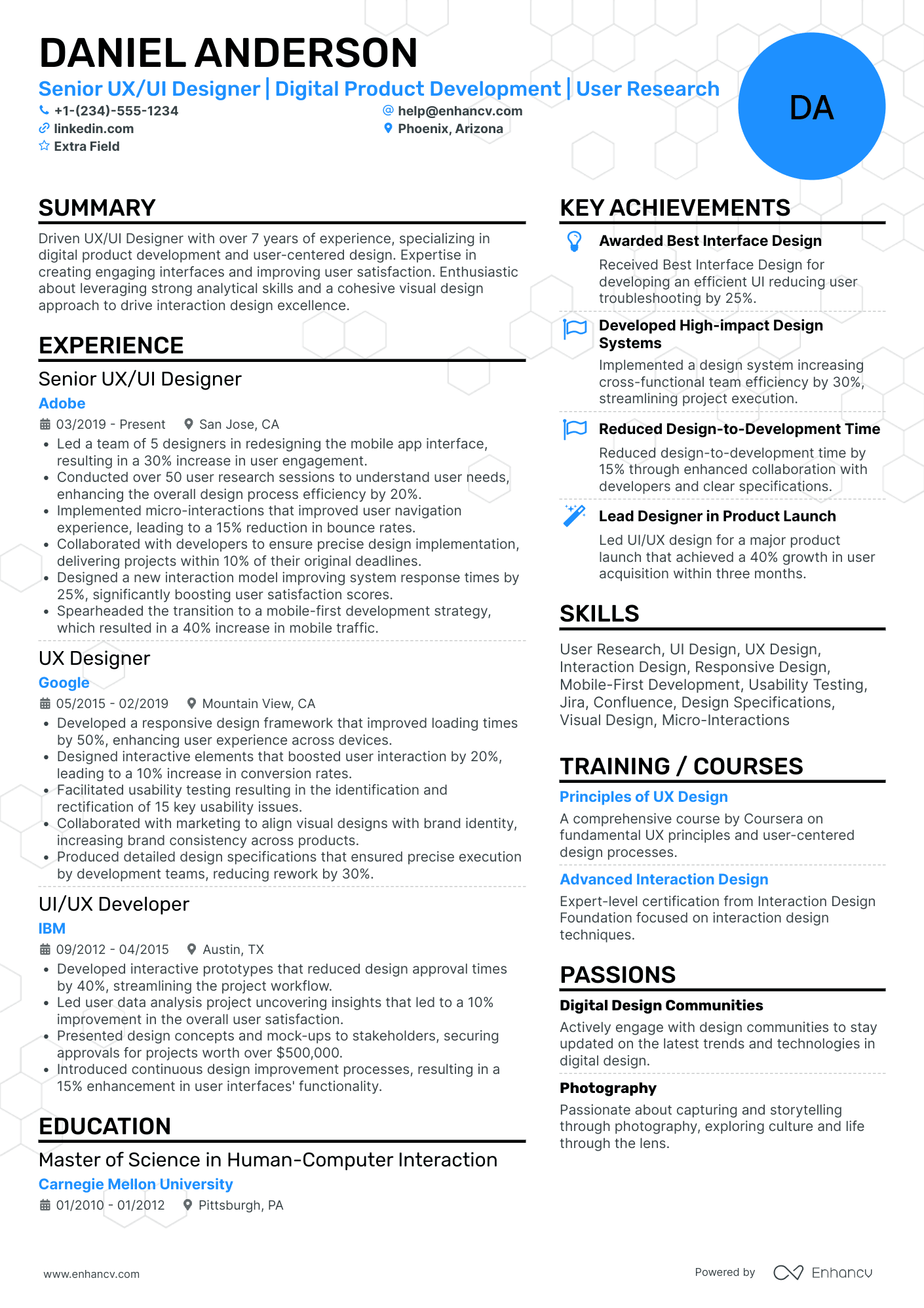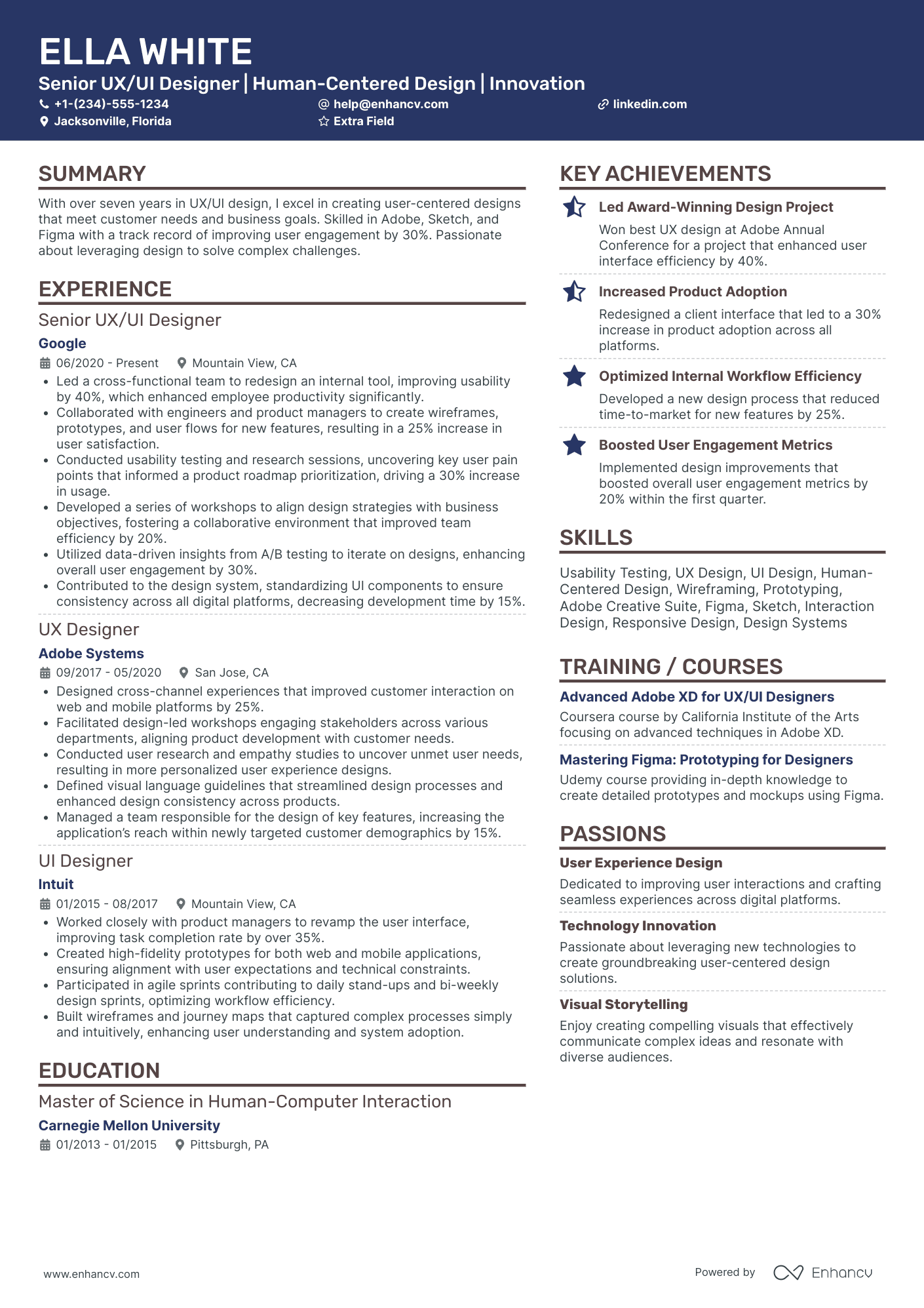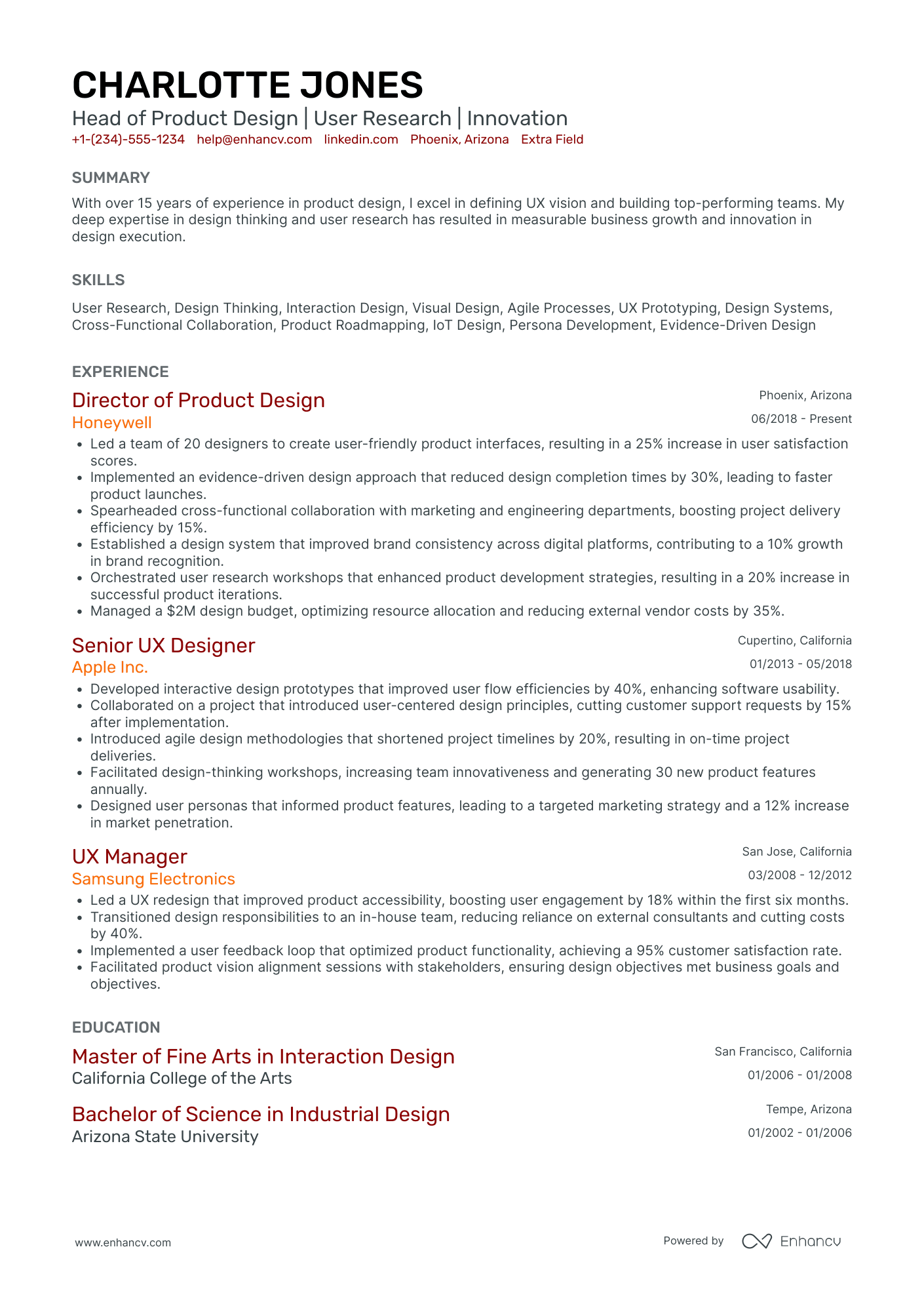Are you on the hunt for your dream job as a UX or UI designer?
From research and user testing, to designing a conversion-ready website or app, you’re the expert every business needs.
UX and UI designers are in high-demand, but the profession is growing fast in popularity. You will likely be up against hundreds of other candidates when applying for prestigious jobs.
The right UX/UI designer has these three qualities:
- Excellent knowledge of how people interact with apps and websites;
- Creative eye for design;
- Technical skills that allow you to bring your visions to life.
UX and UI designers go hand-in-hand. Whether you’re an expert at one discipline, or you dabble in both, this resume guide will help you write the perfect job-winning UX/UI designer resume.
Let’s get started.
This UX/UI Designer resume guide will teach you:
- 6 UX/UI designer resume samples for inspiration
- How to incorporate quantitative data that shows the impact of your designs
- 13+ ways to describe your duties as a UX/UI designer
- 49+ examples of technical and soft skills to highlight in your resume
Looking for related resumes?
- Web Designer Resume Example
- Full Stack Developer Resume Example
- Programmer Resume Example
- Graphic Designer Resume Example
How to write a job-winning ux/ui designer resume
You are the detective that helps businesses make more money through their websites and apps.
Your resume proves how you’ve accomplished this in the past.
UX/UI Designer roles require behavioural psychology skills and strong technical abilities.
The most impactful UX/UI designer applicants impress with their mix of technical knowledge and soft skills.
Add in technical skills that show you can analyze user behaviour, design prototypes and develop the finished web project.
Feature your soft skills throughout your resume summary and work experience sections.
How did you present your design prototypes and mockups to clients?
Did you collaborate across teams to accomplish a big project together?
What is your problem-solving process?
To make a great impression on the hiring manager, personalize your UX/UI Designer resume for the job you want.
For example, are they on the hunt for a UI designer who has experience building Facebook apps?
Mention your expertise in this area directly on your resume.
Here's what a recruiter will look for in your resume:
- Have you completed any UX/UI projects before with proven results? Is there a link to your portfolio?
- Can you do user research such as analysis, surveying and testing?
- Do you have the right soft skills to fit in with their company culture?
- Have you completed any formal education or done any reputable certifications?
The most important sections of a UX/UI designer resume:
- Resume header that has all relevant links and contact information;
- Resume summary;
- Work experience and/or relevant UX/UI projects;
- Education and certifications;
- Technical and soft skills — both are essential in UX/UI resumes.
Answering these questions in the important sections of your resume will lead you to success.
Tips for writing a captivating ux/ui designer resume header
You’re applying for a UI/UX Designer position with an arts showcase platform company.
This is what your basic resume header looks like:
This header misses so many opportunities to impress. It only includes the very basics: name, location, job title, and email.
Let’s try this again with an upgraded UX/UI designer header.
This is a header recruiters will love.
It has everything they want to see:
- Your name, title and location;
- Multiple ways to contact you (phone and email);
- A Link to your portfolio website.
Pro tip
Include a link to your portfolio in your resume header. Most companies will require that you include one in your resume, and even if they don’t, it’s an excellent opportunity to directly show them your proudest projects.
The most important thing to have in your portfolio is your thought process, the way you think, the way you work, and how you solve problems.
Dee Scarano, Senior Product Designer at AJ&Smart
Show you’re right for the job in your ux/ui designer resume summary
A UX/UI Designer resume should prove that you can solve problems, design solutions and execute on them to make a positive impact for a business.
Not only can you design functional web projects, but you can test those designs and study the user experience. All that, while being an excellent team member to work with.
That’s a lot to fit into one resume, isn’t it?
Focusing on these two upgrades will make writing an impactful resume summary easier:
- Use real data to show the success of your past UX/UI projects;
- Mirror the same keywords used in the job posting to target your summary.
Here are two resume summary examples to give you an idea of what’s wrong and what’s right.
Optimize your resume summary and objective for ATS
Drop your resume here or choose a file.
PDF & DOCX only. Max 2MB file size.
2 UX/UI designer resume summary samples
Let’s start with what to avoid.
This example needs a lot of work. Why?
- It doesn’t list how many years of experience the candidate has;
- It doesn’t mention if they’ve had success in their past UX/UI projects;
- It’s not personalized to the job they’re applying for.
Let’s give it another shot.
This summary is excellent! It has everything the recruiter wants to see, including:
- How many years of experience they have as a UX designer;
- Demonstrates their eagerness for the role;
- Highlights specific metrics to prove their past success in design;
- Spotlights their soft skills to show they can collaborate well.
Pro tip
Highlight specific past projects that you’re most proud of in your summary. It sets an excellent tone for the rest of your resume. You can talk about all of your former jobs in your work experience section later on.
Quantitative data is key on a UX/UI Designer resume.
A UX/UI Designer resume should be supported with real stats. Think back to your former projects and talk about the positive impact you made for the company. Whether it’s improving their conversion rate or customer satisfaction level, the hiring manager wants to hear about it!
Need some inspiration to start? Here are some questions to consider:
- How many projects have you successfully completed?
- How large were the companies/clients you worked with?
- Did you boost conversion rates?
- Did you increase revenue?
- Was there a measurable improvement in user experience from your projects?
- Did you reduce the error frequency in your website/app maintenance?
Stats like these fit perfectly within your resume summary and work experience section, so find different opportunities to sprinkle in some data.
How should you describe your ux/ui designer resume experience?
The work experience section is the most important for your UX/UI Designer resume.
This is the place where you shed light on all of your projects, the methods behind them, and the impact they made.
What is the goal of your work experience section?
This section should emphasize two important points:
- UX/UI design background;
- Software experience.
How you have conceptualized UI designs for projects in the past will decide if the hiring manager thinks you’re fit for the role.
Check the job description to see what specific experience they’re looking for so you can focus your points.
While you’re studying the job description, take note of what softwares and tools they expect you to be proficient with. Do they want a designer who can work with Shopify and Squarespace? Or a candidate who can use CSS?
Mention these relevant tools in your work experience section.
To top it off, highlight your soft skills too. You may be a design wizard, but you also need to be able to communicate your findings and work with a team. The hiring manager will be looking out for this.
What’s really hard for hiring managers to find is people who are great at communicating, great at activating other people to collaborate and get work done, and really good at having a thought process behind their work.
Dee Scarano, Senior Product Designer at AJ&Smart
Let’s compare two UX/UI designer resume examples to see our tips in action.
2 UX/UI designer resume experience samples
- •Developed applications for clients
- •Worked with browser compatibility issues
- •Maintained front end and back end of website
This example won’t inspire confidence in the hiring manager. It only lists off a series of responsibilities, saying nothing about if the candidate is good at UX/UI design.
To avoid this common mistake, focus your work experience section on highlighting your accomplishments in your projects. Refer back to our section above where we talk about adding in real quantitative data to support your points.
- •Presented prototypes and concept designs using tools like Illustrator, Photoshop & Axure
- •Developed website redesign and improved conversions by 300%, using Javascript and HTML5
- •Collaborated effectively with the marketing and dev teams to achieve quarterly KPIs
This example is excellent because the candidate supports their points with data, mentions relevant tools, and shows they can collaborate across teams.
The hiring manager will be calling back for an interview with this example.
How to describe the duties of a UX/UI designer on a resume
Here are some examples of UX/UI design responsibilities you can add to your resume:
- Designing websites;
- Creating responsive website wireframes;
- Writing code with HTML and CSS;
- Designing app wireframes;
- Creating UI animations and mockups;
- A/B testing designs;
- Analyzing user behaviour;
- Surveying customers;
- Producing process flows;
- Refining and documenting specs;
- Creating infographics;
- Designing motion graphics;
- Editing videos.
What should you do if you don’t have ux/ui design work experience?
If you’ve just graduated or are looking to change careers, you won’t have any formal UX/UI design experience to show for yet.
Don’t worry, all hope is not lost. Many companies are open to hiring new UX/UI designers if they can demonstrate their abilities in other ways.
The most important thing you need to do is complete a few personal projects that showcase your design abilities, then highlight those projects in your work experience section.
While you’re in the position of looking for your first role, you can do a small personal project. If you know someone in your friendship or family network who has a small business, you can do some work for free. Maybe they need a new website for example. Then you’ve got a real showcase of something you can put in your portfolio.
Dee Scarano, Senior Product Designer at AJ&Smart
Does your ux/ui designer resume need an education section?
While having a university or college degree isn’t always mandatory to landing a UX/UI designer job, it is a huge asset.
You should absolutely include an education section in your UX/UI designer resume.
Common degrees and diplomas for UX/UI designers include:
- Art;
- Animation;
- Design;
- Computer Science;
- Psychology.
When writing the education section, include your institution name, the type of degree/diploma you received, and the years you attended. You can also include any notable projects you completed, or awards you received while in school.
What are the most popular certifications for ux/ui designers?
Completing a reputable certification can be an excellent way to get into the UX/UI design industry.
That being said, not all certifications are equal. Be cautious before undergoing a certification, making sure it is respected in the industry.
Here are a list of popular certifications in UX/UI design:
9 ux/ui design certifications:
- Online User Experience Design Bootcamp by BrainStation;
- UX Design Institute - Professional Diploma in UX Design;
- NN/g UX Certification Program;
- User Experience Design Immersive: Boston;
- Certified Usability Analyst;
- User Experience and Customer-Centered Design Certificate;
- UX Certificate Program - Bentley University;
- User-Centered Design Certificate;
- User Experience Research and Design Specialization - University of Michigan.
What skills do employers look for in a ux/ui designer resume?
Technical proficiency in design will be the foundation of your resume skills section. You should know how to create wireframes for websites and apps, design mockups with tools such as Illustrator, and analyze user behaviour to make recommendations.
Soft skills are what set you apart from other UX/UI designers.
You design prototypes and mockups for websites and apps. You must be able to communicate your decisions to your managers. You also will be working closely alongside other team members to achieve a company or client’s vision, so teamwork skills are a must.
This list of 49 technical and soft skills will give you inspiration on what to include in your UX/UI designer skills section.
34 technical skills to include on a UX/UI designer resume:
- Photoshop;
- Illustrator;
- Axure;
- Motion design (Principle, After Effects);
- Prototypes (Keynote, Invision);
- HTML & HTML5;
- CSS Frameworks;
- Wireframing;
- Python;
- Surveying;
- Statistical analysis;
- Comparative analysis;
- Frameworks (Polymer, Backbone, Angular, Socket);
- Style guides;
- APIs;
- Data analysis (Google Analytics);
- Concept sketches;
- Node.js;
- jQuery/Javascript;
- Chrome Developer Tools;
- MySQL;
- Agile;
- Information architecture;
- Git;
- NPM;
- Sketch;
- Figma;
- Webpack;
- Sass;
- Team Foundation Server;
- ESlint;
- Shopify;
- Wordpress;
- Squarespace.
15 soft skills to include on a UX/UI designer resume:
- Communication skills (written and verbal);
- Adaptable;
- Teamwork;
- Client relationship management;
- Attention to detail;
- Problem solving;
- Self-motivated;
- Organization;
- Project management;
- Prioritization;
- Visual presentations;
- User testing;
- Analytics;
- A/B testing;
- Interviewing.
Other sections for your resume
There are more sections that you can consider adding to your resume
- Language skills
- Hobbies and interests
- Projects
- Volunteer work
- Highlights
- References
- LinkedIn on Resume
- GPA
- Resume Awards
- Publications
These sections allow you to be a bit more playful about your resume.
Cover letter for a ux/ui designer resume
In case the job description says you need to provide a cover letter, do include yours. Otherwise, you can always leave it out.
Nowadays, job application forms include questions like “why do you want to work here”, or “explain why you’re the best fit for us”, which makes you wonder are cover letters really necessary?
Still, they help you tell your story in a way that, if written right, it’s captivating and engaging.
In any case, you should pay close attention to the following tips when a cover letter is a must:
- Make sure you go over a cover letter checklist, not to forget what your cover letter should say;
- Match the cover letter design with your resume’s;
- Address your cover letter properly;
- Keep an eye on your cover letter length;
- Use a proper cover letter ending;
Key takeaways
- Include a link to your portfolio in your resume header;
- Highlight your top projects in your resume summary;
- Back up each section with quantitative data that support your points;
- Emphasize your ability to communicate and collaborate with a team.
UX UI Designer resume examples
By Experience
